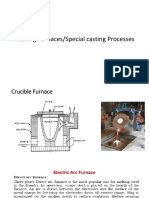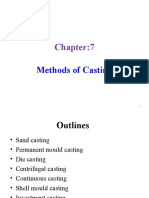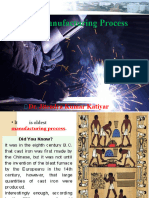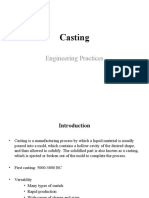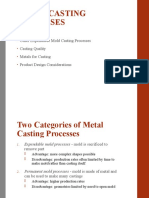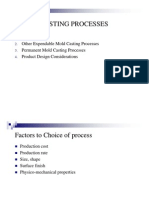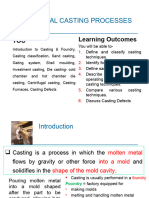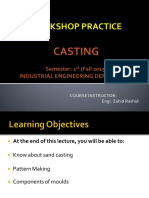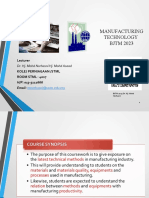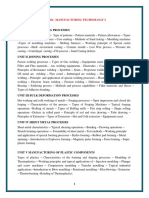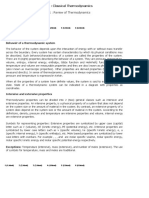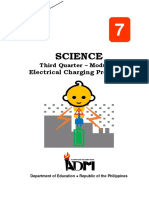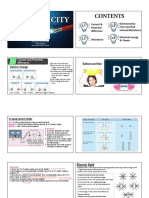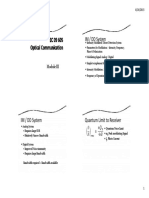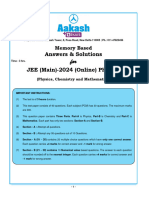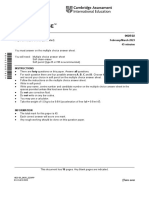Introduction 1.
Sand Casting
• Casting of Ingot and Shape casting • Most widely used casting process.
• Major Classification • Parts ranging in size from small to very large
• Production quantities from one to millions
– Expandable Mold
• A new mold is required for each new casting
• Sand mold is used.
• Production rate is limited except Sand casting • Patterns and Cores
• Sand Casting, Shell Molding, Vacuum Molding, Expandable – Solid, Split, Match-plate and Cope-and-drag Patterns
Polystyrene, Investment Casting, Plaster Molding, Ceramic – Cores – achieve the internal surface of the part
Mold Casting • Molds
– Permanent Mold – Sand with a mixture of water and bonding clay
– Typical mix: 90% sand, 3% water, and 7% clay
• Mold is made of durable materials
– to enhance strength and/or permeability
• Ideal for a product with a high production rate
25 26
Molds Steps in Sand Casting
The cavity in the sand mold is formed by packing sand around a pattern,
• Sand – Refractory for high temperature separating the mold into two halves
– The mold must also contain gating and riser system
• Size and shape of sand – For internal cavity, a core must be included in mold
– Small grain size -> better surface finish – A new sand mold must be made for each part
– Large grain size -> to allow escape of gases during pouring 1. Pour molten metal into sand mold
2. Allow metal to solidify
– Irregular grain shapes -> strengthen molds due to 3. Break up the mold to remove casting
interlocking but to reduce permeability 4. Clean and inspect casting
• Types 5. Heat treatment of casting is sometimes required to improve metallurgical
properties
– Green-sand molds - mixture of sand, clay, and water;
“Green" means mold contains moisture at time of pouring
– Dry-sand mold - organic binders rather than clay and mold is
baked to improve strength
– Skin-dried mold - drying mold cavity surface of a green-sand
mold to a depth of 10 to 25 mm, using torches or heating
lamps
27 28
Types of patterns used in sand
Internal Cavity with Core
casting:
(a) solid pattern
(b) split pattern (a) Core held in place in the mold cavity by chaplets
(c) match-plate pattern (b) possible chaplet design
(d) cope and drag pattern (c) casting with internal cavity
29 30
5
� Desirable Mold Properties and
2. Other Expendable Mold Casting
Characteristics
• Strength - to maintain shape and resist erosion • Shell Molding
• Permeability - to allow hot air and gases to pass • Vacuum Molding
through voids in sand
• Expanded Polystyrene Process
• Thermal stability - to resist cracking on contact
with molten metal • Investment casting
• Collapsibility - ability to give way and allow • Plaster and Ceramic Mold casting
casting to shrink without cracking the casting
• Reusability - can sand from broken mold be
reused to make other molds?
31 32
Steps in shell-molding Shell Molding
• Advantages:
– Smoother cavity surface permits easier flow of molten
metal and better surface finish on casting
– Good dimensional accuracy
– Machining often not required
– Mold collapsibility usually avoids cracks in casting
– Can be mechanized for mass production
• Disadvantages:
– More expensive metal pattern
– Difficult to justify for small quantities
33 34
Expanded Polystyrene Casting Expanded Polystyrene Casting
• Advantages:
– Pattern need not be removed from the mold
– Simplifies and expedites mold-making, since two
mold halves (cope and drag) are not required as in a
conventional green-sand mold
– Automated Mass production of castings for
automobile engines
• Disadvantages:
– A new pattern is needed for every casting
– Economic justification of the process is highly
dependent on cost of producing patterns
35 36
6
� Investment Casting Investment Casting
• Advantages:
– Parts of great complexity and intricacy can be cast
– Close dimensional control and good surface finish
– Wax can usually be recovered for reuse
– Additional machining is not normally required - this is
a net shape process
• Disadvantages
– Many processing steps are required
– Relatively expensive process
37 38
Plaster Molding 3. Permanent Mold Casting
• Basic Permanent Mold Process
• Similar to sand casting except mold is made of plaster of
Paris (gypsum - CaSO4-2H2O) – Uses a metal mold constructed of two sections
designed for easy, precise opening and closing
• Plaster and water mixture is poured over plastic or metal
pattern to make a mold – Molds for lower melting point alloys: steel or cast
iron and Molds for steel: refractory material, due to
• Advantages:
the very high pouring temperatures
– Good dimensional accuracy and surface finish
– Capability to make thin cross-sections in casting • Variations
• Disadvantages: – Slush Casting
– Moisture in plaster mold causes problems: – Low-pressure Casting
• Mold must be baked to remove moisture – Vacuum Permanent Mold Casting
• Mold strength is lost when is over-baked, yet moisture content can
cause defects in product • Die Casting
– Plaster molds cannot stand high temperatures
• Centrifugal Casting
39 40
Permanent Mold Casting
Basic Permanent Mold Process
Process
• Metals - Al, Mg, Copper alloy and Cast Iron
• Basic Steps
– Preheated Mold (metals to flow)
– Coatings are sprayed
– Pour and solidify
– Mold is open and casting is removed
• Advantage - Good surface finish and dimensional
control and Fine grain due to rapid solidification.
• Disadvantage - Simple geometric part, expensive
mold.
• Example - automobile piston, pump bodies
castings for aircraft and missiles. 41 42
7
� Permanent Mold Casting Die Casting
• Advantages: • The molten metal is injected into mold cavity
– Good dimensional control and surface finish (die) under high pressure (7-350MPa).
– More rapid solidification caused by the cold metal Pressure maintained during solidification.
mold results in a finer grain structure, so stronger
castings are produced • Hot Chamber (Pressure of 7 to 35MPa)
– The injection system is submerged under the molten
• Limitations:
metals (low melting point metals such as lead, zinc,
– Generally limited to metals of lower melting point
tin and magnesium)
– Simple part geometries compared to sand casting
because of the need to open the mold • Cold Chamber (Pressure of 14 to 140MPa)
– High cost of mold – External melting container (in addition aluminum,
• Due to high mold cost, process is best suited to brass and magnesium)
automated high volume production
43 44
Die Casting Hot-Chamber Die Casting
• Molds are made of tool steel, mold steel,
maraging steel, tungsten and molybdenum.
• Single or multiple cavity
• Lubricants and Ejector pins to free the parts
• Venting holes and passageways in die
• Formation of flash that needs to be trimmed
• Advantages
– High production, Economical, close tolerance, good
surface finish, thin sections, rapid cooling
45 46
Cold Chamber Die Casting Die Casting
• Advantages:
– Economical for large production quantities
– Good dimensional accuracy and surface finish
– Thin sections are possible
– Rapid cooling provides small grain size and good
strength to casting
• Disadvantages:
– Generally limited to metals with low metal points
– Part geometry must allow removal from die cavity
47 48
8
� Centrifugal casting 4. Foundry Practice
• True centrifugal casting • Furnace
– Cupolas (Fig. 11.18)
• Semicentrifugal casting – Direct Fuel-fired furnace
• Centrifuge casting – Crucible Furnace (Fig. 11.19)
– Electric-arc Furnace
– Induction Furnace
• Pouring with ladle
• Solidification – watch for oxidation
• Trimming, surface cleaning, repair and heat
treat, inspection
49 50
5. Casting Quality
• Casting defects
a) Misruns
Three types : (a) lift-out crucible, (b) stationary pot, from which molten b) Cold shut
metal must be ladled, and (c) tilting-pot furnace
c) Cold shots
d) Shrinkage cavity
e) Microporosity
f) Hot Tearing
Induction furnace
51 52
Electric Arc Furnace
Sand Mold defects 6. Metals for Casting
• Ferrous casting alloys: cast iron
– Gray Cast Iron, Nodular iron, White Cast Iron, Malleable
Iron, Alloy cast iron
(b) Pin hole • Ferrous casting alloys: Steels
(c) Sand wash
– Melting temperature is higher that casting alloys. Thus they
are more reactive.
– Less Fluidity
– Higher strength, Tougher
(d) Scabs
– Isotropy and weldable
(e) Penetration
(f) Mold shift
• Nonferrous casting alloys
– Aluminum, Magnesium, Copper, Tin-based, Zinc, Nickel and
Titanium Alloys
53 54
(g) Core shift (h) Mold crack
